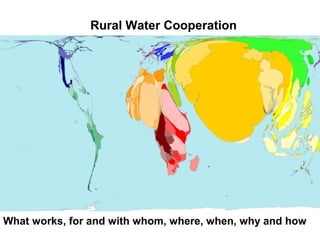
Session overview
- 1. Rural Water Cooperation What works, for and with whom, where, when, why and how
- 3. Water Cooperation: Business as usual – you get what you see, you see what you get
- 4. Beyond traditional borders Recycling, Recycling, Primary production, Primary production, environmental environmental agriculture, agriculture, services services livestock, etc livestock, etc Consumer Consumer Transformation, demands demands packaging, cold chains, value adding
- 6. Structure and Dynamics • 9:30 – 10:30 Bolivia and • 10 ‘ Case presentation Guatemala • 3 x 3’ Questions to • 10:30 – 10:50 Break Panellists • 10:50 – 12:30 Kenya, • 10’ Questions from Scampis and Peru Plenary • 12:30 – 12:45 Plenary • Every case (30’) has a feedback different Panel • 12:45 – 13:00 Way • Plenary feedback and forward in 2013 wrap up
- 7. Structure and Dynamics • 9:30 – 10:30 Bolivia and • 10 ‘ Case presentation Guatemala • 3 x 3’ Questions to • 10:30 – 10:50 Break Panellists • 10:50 – 12:30 Kenya, • 10’ Questions from Scampis and Peru Plenary • 12:30 – 12:45 Plenary • Every case (30’) has a feedback different Panel • 12:45 – 13:00 Way • Plenary feedback and forward in 2013 wrap up
Notas del editor
- Let’s start at the beginning What an odd world we live in. What do we see here? This picture represents global child malnutrition. There is a world to gain. Yesterday, we heard of excellent examples of transboundary cooperation and negotiation processes, but they have not as yet been scaled up to Africa and Asia. So when we discuss Water Cooperation we have a clear view what we do it for.
- Where favourable conditions meet, quadrant A, we should ask ourselves if we need to intervene with water cooperation interventions at all, and if so, what for. Here Wuas and watershed agencies should be in a condition to operate effectively, like in the Ebro Agency, or in the French or US irrigation settings. Where unfavourable conditions meet, Quadrant c, maybe we shouldn’t intervene either. Or foster individual irrigation development such as with tubewells or shallow wells. Possibly management substitution and plantation farming with outsourced private sector services would be a –politically inconveniet as incorrect- option. Where we find strong government and weak farmers, one would imagine effective public agencies in quadrant D, or private sector operators for O&M with guaranteed contracts by Govt. In Quadrant B one would expect strong WUAs, new or traditional, which cooperate within themselves-top, middle, tail- and/or along the watershed in an agency influenced by WUAs. As highlighted by the speaker from WB, the fields are not fixed and the picture is to better understand ‘room to move’ on WC, the bigger picture allowing to move away from the « WUA as silver bullet ».
- New boundaries means new partners for WC . This refers to business as usual or Wuas and quantities or water allocation and distribution within and between schemes in a watershed or closed basin context, to a little bit les BaU including different users- farmers, pastoralists, women and youth, at different times during the value chain of water, certainly a new WC issue in many constrained settings by addressing qualities of water used and discharged as well as reuses of any color of water, to crossing borders into WC with other sectors such as mining and hydropower, or even paid environmental services and drinking water, to moving away from the parochial water professionals by listening to municipalities and law and policy makers. Depending who you are you get what you see – an old lady with a bonnet, or a young lady looking away from us…. One needs to go beyond the traditional or fixed borders to meet the future, to resolve hunger, health and wealth issues.
- Beyond traditional borders means going beyond water for primary use purposes such as agriculture or domestic use. Usually we look into paper allocations of water an issue. In reality all up and downwads services such as delivery of pumps or land levelling, seeds and storage also need to be looked at –hence new WC. Water services around transformation of goods and services takes up a fair share, especially as it usually compromises water quality or priorisation of use. Consumption patterns and diets are the real drivers of water for agriculture, so thinking about WC with consumers may represent a new challenge. Last but not least recycling and environmental services related to water will require differentiated WC scenarios. Private sector service suppliers link to all quadrants –with pumps or land-levelling, with cold chain storage, with retailing food and water services or water literacy awareness programmes, and with recycling waste, which is largely water.
- A colleague recently stated « a mission a day keeps progress away’ so I will stop here on Crossing Borders of Rural Water Cooperation and proceed with the structure and dynamics of this excellent morning which should allow you, case presenters, panellists and plenary to exchange experiences on what works where for whom and how.
